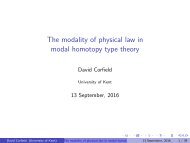TOMBO Ver.2 Manual
TOMBO
TOMBO
You also want an ePaper? Increase the reach of your titles
YUMPU automatically turns print PDFs into web optimized ePapers that Google loves.
1.5 TDDFT dynamics simulation 12<br />
of the Hamiltonian at that time H q (r,t). Wave packes are expanded as<br />
ψ j (r,t) = ∑c jk (t)ϕ k (r,t), (1.35)<br />
k<br />
where the coefficients c jk (t) are given by the inner product of ϕ k (r,t) and ψ j (r,t) as<br />
c jk (t) = ⟨ϕ k (r,t)|ψ j (r,t)⟩. (1.36)<br />
Therefore, if we set the time step ∆t smaller than the time scale where the Hamiltonian<br />
changes, the TDKS equation can be integrated as follows:<br />
ψ j (r,t + ∆t) = ∑exp[−iε k (t)∆t]c jk (t)ϕ k (r,t). (1.37)<br />
k<br />
When the Hamiltonian does not change in time, Eq.(1.37) is exact. Of course, electron wave<br />
packets oscillate 100-1000 times faster than the nuclear motion, but the stability of Eq.(1.37)<br />
is excellent. Typically if one set ∆t at 10 −2 -10 −1 fs, the Hamiltonian H q (r,t) almost does<br />
not change, Eq.(1.37) becomes good approximation.<br />
This spectral method requires that the basis functions span complete space at least approximately,<br />
and in this sense, the all-electron mixed basis method is suitable. In fact, the<br />
summation over the eigenstates in Eq.(1.37) can be restricted to low lying excited states only,<br />
although continuum free-electron-like states above energy zero should be also included. The<br />
number of levels taken into account in this summation is set as nol in INPUT.inp. Usually,<br />
nol = 500 is recommended, but it should be set 1000 or more for larger systems.<br />
Newtonian equation of motion (1.33) involves forces calculated by the Coulomb force<br />
between nuclei and the derivative of the electron total energy with respect to the nuclear<br />
positions. These forces are calculated in the same way described in previous section. If<br />
the electronic states is on an adiabatic surface, the dynamics using this mean-field potential<br />
becomes the adiabatic molecular dynamics. If the wave packet ψ j (r,t) is the superposition<br />
of the eigenstates, the forces acting on nuclei becomes the average of the forces calculated<br />
from the different eigenstates with the weight of these eigenstates in the wave packet (mixed<br />
state). This is the problem of this mean-field approximation. This mean-filed force becomes<br />
unphysical apart from the region where the mean-field potential is valid.<br />
To do the TDDFT dynamics simulation, it is necessary to first iterate the SCF loop<br />
until self-consistency is obtained. Then the TD dynamics loop starts. Typically dTime<br />
= ∆t = 0.01 ∼ 0.1 [fs] should be put in COORDINATES.inp. As well as the usual MD,<br />
nStep should be also given in INPUT.inp.



